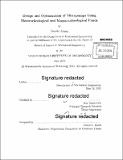| dc.contributor.advisor | Karl Lagnemma. | en_US |
| dc.contributor.author | Liang, Youzhi, Ph.D. Massachusetts Institute of Technology | en_US |
| dc.contributor.other | Massachusetts Institute of Technology. Department of Mechanical Engineering. | en_US |
| dc.date.accessioned | 2016-03-03T21:03:45Z | |
| dc.date.available | 2016-03-03T21:03:45Z | |
| dc.date.copyright | 2015 | en_US |
| dc.date.issued | 2015 | en_US |
| dc.identifier.uri | http://hdl.handle.net/1721.1/101479 | |
| dc.description | Thesis: S.M., Massachusetts Institute of Technology, Department of Mechanical Engineering, 2015. | en_US |
| dc.description | Cataloged from PDF version of thesis. | en_US |
| dc.description | Includes bibliographical references (pages 71-75). | en_US |
| dc.description.abstract | Micropumps have rapidly expanded microhydraulic systems into a wider range of applications, such as drug delivery, chemical analysis and biological sensing. Empirical research has shown that micropumps suffer most from their extremely low efficiency. To improve the efficiency of micropumps, we propose to employ electrorheological (ER) and magnetorheological (MR) fluids as the hydraulic fluids. This thesis presents two methods: one is a dynamic sealing method to be applied on current micro-scale gear pumps using MR fluids, and the other is a novel design method of micropumps using ER fluids. Using MR fluid with applied magnetic field as a substitute for industrial hydraulic fluids, magnetic chains are aligned within the channel. The parameters, such as magnetic field, viscosity and volume fraction of MR fluid can be balanced to provide optimal sealing performance. Darcy flow through porous media and Bingham flow in a curved channel with a rectangular cross section have been used to model the MR fluid flow exposed to certain magnetic field intensity. Static and dynamic magnetic sealing performance is investigated theoretically and experimentally, which is evaluated by Mason numbers and friction factor. To achieve a higher efficiency and faster dynamic response, a novel design for micropumps driven by ER fluid is demonstrated. Moving mechanical parts are eliminated by applying a periodic voltage gradient. The approach involves exerting electric forces on particles distributed within the fluid and exploiting drag or entrainment forces to drive flow. Variables are explored, such as the dimension and layout of the channel and electrodes. Experiments are also designed to observe the performance of the solid state pump. In addition, a method of characterizing the efficiency of chamber pump is introduced and applied on screw-chamber pump and solenoid-chamber pump with check valve and ER valve. | en_US |
| dc.description.statementofresponsibility | by Youzhi Liang. | en_US |
| dc.format.extent | 75 pages | en_US |
| dc.language.iso | eng | en_US |
| dc.publisher | Massachusetts Institute of Technology | en_US |
| dc.rights | M.I.T. theses are protected by copyright. They may be viewed from this source for any purpose, but reproduction or distribution in any format is prohibited without written permission. See provided URL for inquiries about permission. | en_US |
| dc.rights.uri | http://dspace.mit.edu/handle/1721.1/7582 | en_US |
| dc.subject | Mechanical Engineering. | en_US |
| dc.title | Design and optimization of micropumps using electrorheological and magnetorheological fluids | en_US |
| dc.type | Thesis | en_US |
| dc.description.degree | S.M. | en_US |
| dc.contributor.department | Massachusetts Institute of Technology. Department of Mechanical Engineering | en_US |
| dc.identifier.oclc | 935932149 | en_US |
